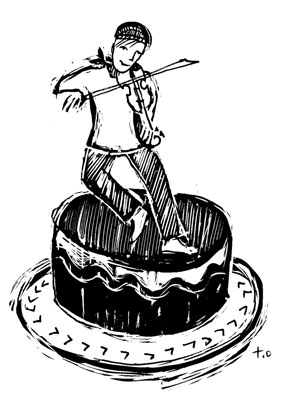By Cheryl A. Wixson
Because I often cook for large groups, I try to be sensitive to individuals’ many eating styles and dietary requirements. One diet that has become increasingly prevalent is gluten-free. This diet excludes all foods that contain gliadin, a gluten protein found in wheat, and in similar proteins found in crops of the tribe Triticeae, including kamut, spelt, barley, rye, malts and triticale.
The disease caused by gluten is known as celiac, an autoimmune disorder of the small intestine. Upon exposure to gliadin, the enzyme transglutaminase modifies the protein, and the immune system cross-reacts with the small-bowel tissue, causing inflammation. This reaction irritates the lining of the small intestine, interfering with water and nutrient absorption.
Celiac disease, difficult to diagnose, is estimated to affect between 1 in 1,750 and 1 in 105 U.S. people. It occurs in genetically predisposed people of all ages. Symptoms may include chronic diarrhea, failure to thrive and grow (particularly in children), vomiting, gas, eczema and fatigue. A gluten-free diet is the only medically accepted treatment for celiac disease and for the related condition, dermatitis herpetiformis.
What does a gluten-free diet entail? The term gluten-free generally indicates a harmless level of gluten, rather than a complete absence. The 2007 FDA regulations limit use of the term “gluten-free” to food products with less than 20 parts per million of gluten.
A gluten-free diet, like any healthy diet, includes a wide variety of produce, meats and/or other protein sources, dairy products and eggs. Grain options include rice, corn, soy, potato, beans, quinoa, millet, buckwheat, amaranth and nut flours. Inclusion of oats in a gluten-free diet is controversial; some research suggests that while oats themselves are gluten-free, other grains contaminate them during processing and distribution.
When preparing gluten-free food, be aware of cross contamination; some folks are extremely sensitive. Thoroughly clean equipment before using it. If the disease is severe, you may need separate equipment or even a separate facility.
Scrutinize food labels, as gluten comes in many forms and is often used as a food additive for flavoring, stabilizing or thickening. Modified food starch, malt flavoring, dextrin and maltodextrine all contain gluten. Beware of products such as ice cream, ketchup, sausages and soy sauce. Many foods contain gluten due to processing techniques, but gluten may not be included on the ingredient list.
Bread, a staple in our Western diet, is typically made from grains such as wheat that contain gluten. Wheat gluten contributes to the elasticity of bread. Gluten-free bread can be made from a variety of foods, such as almonds, rice, legumes and sorghum, but because these flours lack gluten, they often don’t retain their shape as they rise, and they may feel more like cardboard in the mouth.
Some Maine foods that I like to use in gluten-free cooking are potatoes, buckwheat and corn.
Potatoes, extremely versatile, can be used instead of flour in a number of ways – to thicken sauces, soups and stews, for example. Potato starch, or potato flour, is commercially available and can substitute for flour in many recipes; it makes a sweet and tasty potato bread.
I use buckwheat, which contains twice the amount of B vitamins as wheat flour, to make pancakes, cakes, brownies, muffins and cookies.
Simply switching to a gluten-free diet does not guarantee good health, as many gluten-free processed products are not enriched or fortified with nutrients such as folate, iron and fiber. For optimum health on any diet, avoid processed products in general and eat real, whole foods. Enjoying a wide variety of fruits, vegetables, grains and protein sources ensures adequate amounts of vitamins and minerals and allows more individual control. Best of all, eating a local, seasonal, organic diet is a delicious and joyous endeavor!
 |
| Toki Oshima illustration. |
French Acadian Chocolate Cake
This delicious, gluten-free cake recipe comes from the Bouchard family in Fort Kent.
1/2 c. room temperature butter
1-3/4 c. sugar
3 eggs
1 c. applesauce
1-1/2 c. Acadian light buckwheat flour
1/2 c. unsweetened cocoa powder
1 tsp. baking powder
1/2 tsp. baking soda
Preheat oven to 350 F. Grease an 8-inch square baking pan.
Cream butter and sugar together. Add eggs and beat well. Add applesauce, buckwheat flour, cocoa, baking powder and baking soda. Beat until smooth. Spoon the batter into the pan and bake until a toothpick comes out clean, about 45 minutes. Let cool on a rack. Serve plain, dusted with powdered sugar, or with whipped cream or ice cream. Yield: 9 servings
Nutritional analysis per serving: 350 calories, 6 g protein, 57 g carbohydrates, 13 g fat (0 g trans fat), 200 mg sodium, 4 g fiber.
Cornbread
Freshly ground corn meal makes a delicious cornbread. For the best texture, I use 1 cup of finely ground corn meal and 1 cup of a coarser corn meal. To prevent cross-contamination, I grind the whole kernel corn in a grinder dedicated to gluten-free products.
Whisk together
2 c. cornmeal
1/2 tsp. salt
1 Tbsp. baking powder
2 Tbsp. sugar (if desired)
In a separate bowl, stir together
1 c. milk
1 egg
2 Tbsp. melted butter
Combine with the dry ingredients and spoon into a greased pan. Bake at 400 F until a toothpick comes out clean, about 20 minutes.
Cheryl Wixson, professional engineer, is MOFGA’s organic marketing consultant and food safety specialist. Contact her at [email protected] or 207-947-0892.
This article was originally published in the Winter 2012 issue of The Maine Organic Farmer & Gardener.
Looking for more seasonal recipes? Sign up for MOFGA’s Local and Organic Kitchen Newsletter.
